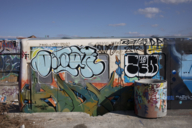
What makes Munich’s Schlachthofviertel so unique? This neighbourhood boasts a vibrant underground cultural scene, but it also accommodates an actual slaughterhouse – a “schlachthof” – along with a booming infrastructure of associated suppliers and wholesalers. Could it possibly have any more urban cool?!
Schlachthofviertel is also referred to as the “stomach of the city”. If that makes you feel a bit queasy, and you think you’d prefer to explore the heart of a place instead, consider this: Schlachthofviertel is the liveliest, wildest and yet also the most authentic district of Munich. Not just because it is home to the longest legal graffiti wall in central Munich or because of the urban industrial vibe of the Bahnwärter Thiel, club, music venue and cultural hub.
Schlachthofviertel is also currently the site of a phenomenon which can be observed all over the world: the outsourcing of space-intensive operations such as abattoirs, port facilities and wholesale storage frees up huge areas at once, creating neighbourhoods which start to change extremely rapidly. It is especially during the early years of redevelopment and temporary usage that many creative and young people flock to a place – but this crowd also brings with it many other adventure-seekers, who in turn move and change the neighbourhood.
Munich’s Schlachthofviertel – which can be described in geographic terms as a sub-district of Isarvorstadt and in reality also extends partially into Sendling – is currently experiencing just such a period of upheaval. Although the abattoir itself has been in operation since 1878 and still receives daily deliveries, many elements of meat production and livestock trading have already been relocated.
Although the abattoir itself has been in operation since 1878 and still receives daily deliveries, many elements of meat production and livestock trading have already been relocated.
After it was privatised in the early 2000s, the facility was renamed Markthallen München (Munich market halls). As well as what remains of the slaughterhouse operation, the buildings here also house wholesale facilities, including rather smart purveyors which offer meat, vegetables, fish, delicacies and flowers, and supply many restaurants in the city. Non-professional foodies also enjoy doing their weekend shopping at the FrischeParadies though, where the exquisite range of delicacies on offer make it every bit the equal of the Viktualienmarkt. You can treat yourself to some delicious food before or after shopping, in one of the busy eateries attached to the delicatessens, such as the Italian Monti Monaco or Papazof fish restaurant.
Speaking of gastronomy, from seven o’clock each morning you can get the best local Weisswurst – white sausage, a Bavarian speciality made from veal and pork – at Wallner, a rustic inn which is officially called the Gaststätte am Großmarkt (and which is officially located in Untersendling, but somehow feels like it is on the outer limits of Schlachthofviertel). The Vesperia on Schmellerstraße serves amazing platters of finger food as well as offering a cosy setting in which to enjoy a beer – as does the wonderful Goldmarie restaurant, a real women’s haunt with a lot of heart and the best of kitchens.
Meanwhile, the Frisches Bier, as you’d expect, has a wide range of different beers. You’ll find a great selection in the Bierkiste too, or at HopDog – or any of the numerous other businesses that specialise in craft beers (there are several in the area). If you’re after something stronger, you can get hard liquor until the wee hours at the Gruam; find punk music and table football in Südstadt; and a genuinely alternative city feeling in the pubs and events areas of Bahnwärter Thiel and the Alten Utting. That last one may sound to German speakers like the name of a blue-rinsed great aunt, but it is actually a former pleasure boat from Lake Ammersee, which has been laboriously heaved onto a railway bridge. It’s now a great spot to sit around, drink, celebrate and eat, and a must-visit on summer days in particular.
You can enjoy a clear view from there towards the new Volkstheater, the most spectacular new building in the district. The brick-clad outer walls of the theatre building are reminiscent of the stockyard that stood on the premises until a few decades ago, while the hulking white stage tower that protrudes from the middle of the building looks a little bit like a giant speaker box, which ties in rather well with the area.
When performances start at the theatre in autumn 2021 after years of construction, the neighbourhood is bound to see a major shift.
The thing is, Munich residents loved the raw and impromptu urban industrial character that this site showcased during its wild years of temporary use in the past, and they delighted in how wonderfully, well, untypical of Munich it was. Those responsible for the development have at least promised that they will retain some of this street cred even after the theatre begins operating. So maybe it makes sense that the Volkstheater Artistic Director, Christian Stückl, who is well-known beyond the city limits as the director of the Obergammau Passion Plays, says he does not want people getting all spruced up to come and visit his theatre.
It remains to be seen whether the ever-younger, ever-trendier new residents of burgeoning Schlachthofviertel will heed him on this. A good way of keeping an eye on the changing population here is at one of the most popular butcher’s shops in the area, located on Thalkirchner Strasse and run by an owner aptly named Magnus Bauch (which translates literally as Magnus Stomach), who even has an Instagram account for his shop. The queues here stretch a long way down the street at the weekend – testament to how delicious and authentic the shop’s speciality sausages are. Not only when it comes to sausages, but also a city and its neighbourhoods: love grows in the heart – but ultimately, it still goes though the stomach.